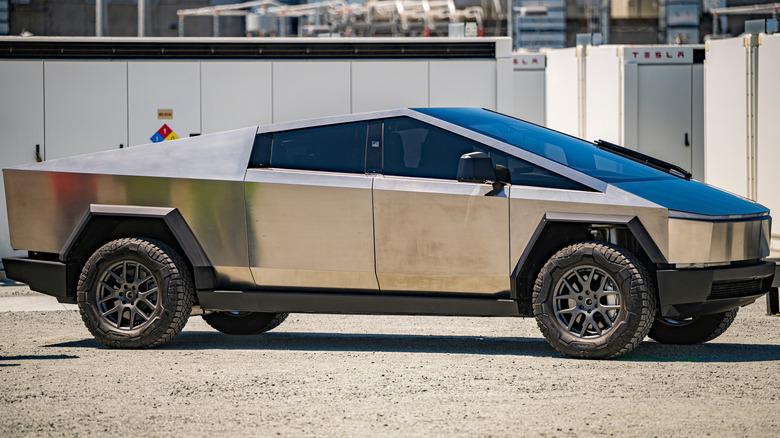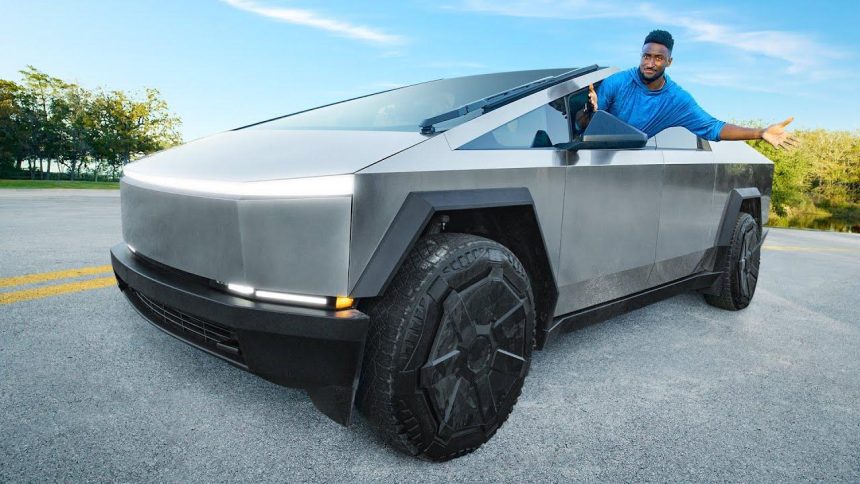Welcome to the fascinating world of electric vehicles, where innovation meets practicality, and sustainability drives the future of transportation. One of the most talked-about entries in this realm is the Tesla Cybertruck, a vehicle that has captured the attention of automotive enthusiasts and eco-conscious consumers alike. With its futuristic design, impressive performance, and unique features, the Cybertruck is more than just a truck—it’s a statement. But if you’re considering making this electric pickup a part of your life, you may be wondering: just how much does it weigh?
In this article, we’ll dive into the weight of the Tesla Cybertruck, what factors contribute to its mass, and why understanding its weight is important for potential owners. Whether you’re a dedicated Tesla fan or simply curious about this groundbreaking vehicle, we’ve got all the information you need to stay informed. Let’s get started!
Table of Contents
- Understanding the Weight Specifications of the Tesla Cybertruck
- Factors Influencing the Weight of the Cybertruck
- Impacts of Weight on Performance and Efficiency
- Tips for Maximizing Your Cybertrucks Capabilities
- Q&A
- In Retrospect

Understanding the Weight Specifications of the Tesla Cybertruck
The weight of the Tesla Cybertruck is a crucial specification that impacts its performance, efficiency, and capability. The vehicle’s design incorporates a stainless steel exoskeleton, which contributes to its robust structure while also adding to its overall weight. The base model of the Cybertruck is expected to weigh around 2,500 kg (5,500 lbs), while the higher variants, equipped with dual or tri-motor setups, can tip the scales at up to 3,200 kg (7,000 lbs). This variance in weight not only affects the truck’s range and power delivery but also its towing capacity and payload ratings.
Understanding the weight specifications is essential for potential buyers who may use the Cybertruck for both personal and commercial purposes. The weight distribution across the vehicle plays a significant role in its handling characteristics and ride comfort. Key highlights include:
- Battery Weight: The large battery pack contributes significantly to the overall weight, enhancing the vehicle’s range.
- Towing Capacity: Heavier models will generally have a greater towing capacity, making them suitable for those who need utility.
- Payload Capacity: A higher weight rating allows for more cargo, ideal for work-related tasks.
For a clearer comparison, see the table below that outlines the different weight specifications for the various Cybertruck models:
| Model | Weight (kg) | Weight (lbs) |
|---|---|---|
| Single Motor | 2,500 | 5,500 |
| Dual Motor | 2,800 | 6,173 |
| Tri Motor | 3,200 | 7,055 |

Factors Influencing the Weight of the Cybertruck
The weight of the Cybertruck is determined by a variety of factors, each playing a crucial role in the vehicle’s overall specifications. Material choice is one of the most significant influences, with Tesla opting for ultra-hard 30X cold-rolled stainless steel, which not only adds to the durability of the vehicle but also contributes to its heft. Additionally, the size and design of the Cybertruck come into play, as its larger dimensions and angular shape require more materials than traditional truck designs. Furthermore, advancements in battery technology have resulted in heavier battery packs, which are essential for the electric functionality of the truck, further influencing the overall weight.
Other important elements include added features and technology integrations that enhance performance but can also increase weight. For example, the installation of a robust suspension system for off-road capabilities might add additional weight, while interior advancements such as high-tech infotainment systems and safety features contribute to the overall mass. Additionally, the choice of wheel and tire configurations can impact the weight; larger tires typically increase both performance and mass. Understanding these factors provides insight into how the Cybertruck balances functionality with performance while maintaining Tesla’s commitment to sustainability.
Impacts of Weight on Performance and Efficiency
The weight of a vehicle like the Cybertruck significantly influences its overall performance and efficiency. Heavier vehicles tend to require more energy to accelerate, which can lead to decreased fuel efficiency or range when compared to lighter alternatives. This is particularly relevant for electric vehicles, where the weight directly affects battery consumption and overall range. In addition, when it comes to handling and ride comfort, a heavier vehicle may provide more stability at high speeds but could also compromise agility and cornering performance. Here are some factors that are affected by the vehicle’s weight:
- Acceleration: Increased weight can slow down acceleration times.
- Energy Consumption: Heavier vehicles may consume more energy, reducing driving range.
- Braking Distance: Heavier weights typically result in longer stopping distances.
- Tire Wear: Increased weight can lead to faster tire degradation.
Furthermore, the distribution of weight plays a crucial role in a vehicle’s dynamics. The Cybertruck, with its unique design and weight distribution, is engineered to enhance performance and stability. Understanding how weight influences various aspects can aid potential buyers in making informed decisions. For a clearer picture of the Cybertruck’s weight-related performance metrics, take a look at the table below:
| Aspect | Impact of Weight |
|---|---|
| Acceleration (0-60 mph) | Higher weight = Slower acceleration |
| Battery Range | Higher weight = Reduced efficiency |
| Stability | Higher weight = Improved stability |
| Handling | Higher weight = Less maneuverability |

Tips for Maximizing Your Cybertrucks Capabilities
To truly harness the power of your Cybertruck, consider customizing its settings and features to fit your lifestyle. Utilize the adjustable air suspension to adapt to various terrains, enhancing both comfort and handling whether you’re off-roading or cruising city streets. Additionally, take advantage of Tesla’s over-the-air software updates, which frequently introduce improved functionalities and features, keeping your vehicle at the cutting edge of technology. Beyond tech adjustments, it’s worth noting that maintaining proper tire pressure can significantly influence your Cybertruck’s efficiency and performance.
Another way to maximize your Cybertruck’s capabilities is through understanding its towing capacity and load management. Make a habit of checking the load limits before embarking on any heavy-duty tasks. For optimal towing, ensure you distribute weight evenly across the trailer and utilize the advanced tow mode for better handling. Here’s a quick reference table to help you keep track of your Cybertruck’s specifications:
| Feature | Specification |
|---|---|
| Towing Capacity | Up to 14,000 lbs |
| Payload Capacity | Up to 3,500 lbs |
| Maximum Range | Up to 500 miles |
| Battery Size | 200 kWh |
Q&A
Q&A:
Q: What is the weight of the Tesla Cybertruck?
A: The Tesla Cybertruck has different weight specifications depending on the model. The single motor version weighs approximately 1,200 kg (about 2,645 lbs), while the dual motor version weighs around 1,400 kg (approximately 3,100 lbs). The tri-motor variant tops the scales at about 1,500 kg (around 3,307 lbs).
Q: Why does the weight vary between different models?
A: The weight variation is primarily due to the differing battery sizes and motor configurations. Each version of the Cybertruck is designed with a unique powertrain that affects weight, performance, and range.
Q: Is the weight of the Cybertruck typical for trucks in its class?
A: Yes, the Cybertruck’s weight is comparable to other electric and gas-powered trucks in its class. While some traditional trucks may have a similar or slightly lower weight, the Cybertruck’s electric design provides enhanced performance through its battery technology and structural materials.
Q: How does the weight of the Cybertruck impact its performance?
A: The weight of the Cybertruck contributes to its robust performance capabilities, including acceleration, towing capacity, and stability. Heavier vehicles often provide more traction, which can be beneficial when towing or driving off-road. However, the weight also affects range, as heavier vehicles typically consume more energy.
Q: Will the weight affect my driving experience?
A: While the weight of the Cybertruck is significant, Tesla has engineered the vehicle to offer a smooth and responsive driving experience. The low center of gravity, due to the placement of the battery pack, enhances handling and stability, making it feel lightweight and agile, despite its size.
Q: Are there any advantages to the Cybertruck’s weight?
A: Absolutely! The weight of the Cybertruck contributes to its durability and safety features. The vehicle is crafted from ultra-hard 30X cold-rolled stainless steel, which not only enhances its strength but also plays a role in crash protection. Additionally, its weight helps in maintaining better traction, especially in adverse weather conditions.
Q: How does the weight of the Cybertruck compare to other Tesla models?
A: The Cybertruck is generally heavier than other Tesla models like the Model 3 or Model Y, primarily due to its larger size and robust construction. For example, the Model 3 weighs around 1,600 kg (about 3,527 lbs), but its dimensions and intended use are very different. The Cybertruck is designed for more demanding utility applications.
Q: What do I need to consider regarding the weight for towing and payload?
A: The weight of the Cybertruck affects its towing capacity and payload. The tri-motor version offers a towing capacity of over 6,500 kg (about 14,000 lbs), which is quite impressive. However, it’s important to consider the combined weight of the truck, cargo, and any towed loads to ensure safe operation within the vehicle’s limits.
Q: Can I expect weight-related performance changes over time?
A: Like any vehicle, some factors may slightly affect the performance over time, including battery degradation. However, Tesla vehicles are designed for durability, and the design of the Cybertruck aims to maintain performance levels even as it ages.
Q: Where can I learn more about the Tesla Cybertruck?
A: For more detailed information about the Tesla Cybertruck, including specifications, features, and updates, visit the official Tesla website or follow Tesla’s announcements on social media to stay informed about any changes or enhancements.
In Retrospect
understanding the weight of the Tesla Cybertruck is essential for both potential buyers and automotive enthusiasts alike. With its robust construction and innovative design, the Cybertruck’s weight plays a critical role in its performance, efficiency, and safety features. Whether you’re intrigued by its unique styling or its impressive specifications, knowing how weight influences various aspects of the vehicle can help you make an informed decision.
As electric vehicles continue to evolve, the Cybertruck stands out not just for its eye-catching aesthetics but also for its engineering prowess. If you’re considering adding this futuristic truck to your driveway, keep in mind the weight factors we’ve discussed and how they align with your driving needs.
Thank you for joining us on this exploration of the Tesla Cybertruck’s weight. We hope you found this information useful and informative as you navigate the exciting world of electric vehicles. Stay tuned for more insights and updates on the latest in automotive technology! Safe driving!











